| Please access the following URL if you want to secure using SSL. All pages in the site will be secure pages. |
https://secure02.blue.shared-server.net/www.fish-food.co.jp/message english 3.2021.html |
Welcome to FISH FOOD TIMES
Mar. 2021 issue No.207

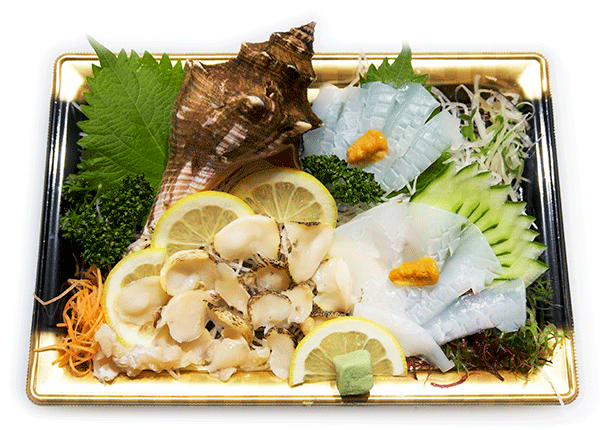
False fusus assorted sashimi
Spring is the season when shellfish are in season
I can't wait for spring more than usual this year. It seems that many people have been forced to live a life that feels like they are shrinking in the cold, as the situation in the world that has been sickened by covid-19 that has continued since last year has become even more severe this winter. However, the momentum of the covid-19 is declining considerably, and the environment has changed so that the area where the state of emergency was finally issued is expected to be lifted in March. Finally, the world is freed from the long hibernation, and people can enjoy the joy of spring with all of the flora and fauna.
In spring, the momentum of most animals and plants becomes active, and shellfish also refrain from spawning from late spring to early summer, and most of them are well nourished to enrich their bodies and become delicious. Spring is the season when shellfish are in season and become the most delicious of the year. In this month's issue, I would like to write about false fusus, which is rather rare as a shellfish, and it seems that some people involved in fisheries may have never eaten it.
The image below is false fusus. Mollusca phylum, belonging to the genus Hemifusus of the Mollongenidae family, with a similar Conch, the slightly thicker and chunkier Neptunea polycostata Scarlato (commonly called matsubu) is a large family with dozens of relatives in the same family. However, this false fusus is a shellfish that remains lonely in only one family and one genus.
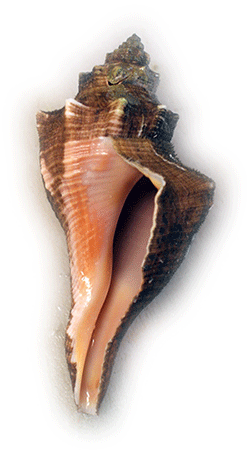
Ezo-neptune is a shellfish that inhabits a lot in northern Japan as the name of Ezo, but this false fusus inhabits a lot in the shallow sea sands of western Japan to southern Japan, especially in the Ariake Sea with vast sandy areas. It was caught in a relatively large amount and has been eaten under the name koukai in the Fukuoka region. However, it is one of the shellfish that is traded at a high price because the amount of fish caught is not large. If this is always displayed alive in the fish counter, such as in an aquarium, the store is a high-class store with a wide selection of shellfish and is evaluated by customers.
Although false fusus is a high-class edible shellfish, it is also important in another sense, which is not generally known. Because it is the material of sea hozuki.
The hozuki plant blooms pale yellow flowers around June, and when it becomes bag-shaped from July to September, it bears fruits and turns orange as shown in the image below.

Red fruits are inedible and especially the roots contain histonin, which can cause uterine contractions and miscarriage when eaten by pregnant women. In the Edo period, a Chinese herbal medicine named "sansyokon", which was dried roots, was used as an abortion agent. However, on the other hand, as the saying goes, "it turns into a poison and becomes a medicine", it has a history of being used as a sedative since the Heian period, and the custom of drinking sansyokon as an antipyretic still remains in rural areas. Basically, hozuki is often used for ornamental purposes, but the fruit has long been a toy for children who take out the contents and put it in their mouth to make a sound or play like a balloon.
Sea hozuki
Although the introduction has become longer, it is "sea hozuki" that you can play with the same sound as the hozuki. It is sold in the form shown in the image below.

It is introduced in the blog that when you play with the sound with your mouth using this, you use it like the following.
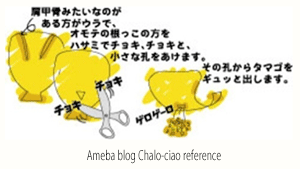
False fusus creates the origin of this sea hozuki in the sea. It is an egg sac laid by false fusus in the image below.
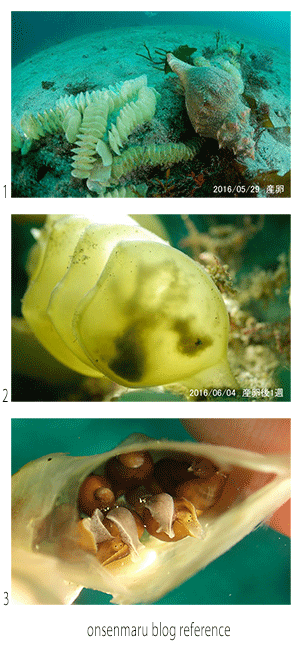
The above image 1 shows the false fusus laying eggs on the bottom of the sea, and 2 shows the false fusus larvae inside the sac-shaped egg sac that was laid. And 3 is a state in which it is cut open to confirm what is inside the bag-shaped egg sac.
Precautions when handling false fusus
Now, let's stop with this much knowledge about sea hozuki, and describe false fusus itself below. I will describe the dismantling work process of false fusus, but I would like to preface it because there is one point to note before that. Sea hozuki is a salivary gland poison called tetramine, and a report from the Fukuoka Marine Technology Center has announced the following.
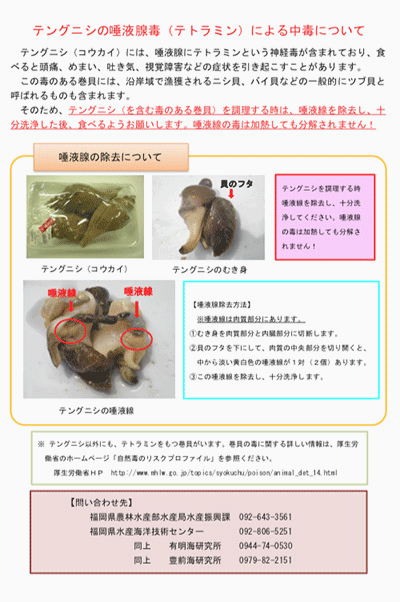
The image below is the one that I took out the muscular part of false spindle and added it as a supplement to understand the above material. If you know the structure of snails such as turban shells in your daily work, there is no big difference and you can easily do this.
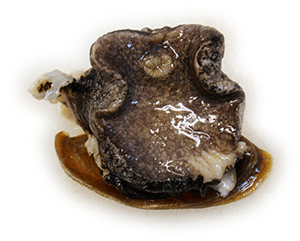
Of course, be careful when cooking false fusus, but it's not like the poison of puffer fish tetrodotoxin, so you don't have to be too nervous, basically. You should try to remove the internal organs normally like the turban shell. By the way, I have never encountered a concrete example of false fusus poisoning.
False fusus with intensely hard shell and tough power
Then, I would like to introduce the work process of disassembling false spindle below. There is one more thing to be aware of when dealing with false spindles. It means that it must be disassembled knowing that "the shell is extremely hard and the force to close the shell lid is very strong".
The purpose is to take out only the contents of the false fusus, and if you don't need the shell, the quickest way is to hit the shell with a hammer to break it. I saw on youtube that an amateur who can't handle live shellfish well is doing such a method. However, if you are a fish sales professional and know that "adding shells to a container for sashimi will increase its value and sell it at a high price", you cannot do the dismantling work in such an unreasonable way.
I think there are various ways to take out the contents without breaking the shell, but in my case, I use "meuchi" to make a hole in the shell of false fusus. I aim and drive meuchi into the internal organs, confirm that the false fusus that was hit by the key point has weakened, and then hook the contents of the shell with meuchi and take it out.
| false fusus dismantling work process 1 (process until the contents are taken out) | |
|---|---|
 |
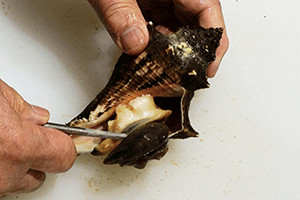 |
| 1,Assuming a place with internal organs, hit meuchi with the peak of the Deba knife and make a hole in the shell. | 4,Allow a little time, and make sure the false fusus is a little weaker, insert meuchi into the muscle and drag it out. |
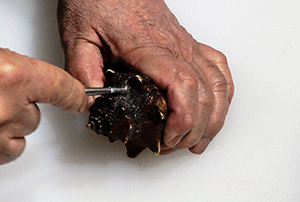 |
 |
| 2,Insert meuchi deep into the shell. | 5,A state in which muscles and internal organs have come out. |
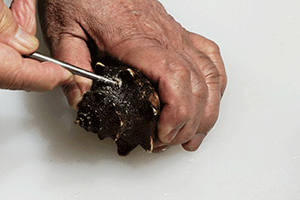 |
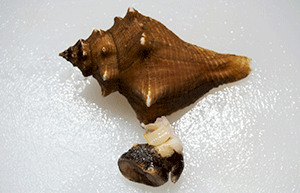 |
| 3,Change the angle of meuchi and pierce the internal organs. | 6,The body inside it was taken out from False fuses. |
| false fusus dismantling work process 1 2(Sashimi commercialization process) | |
|---|---|
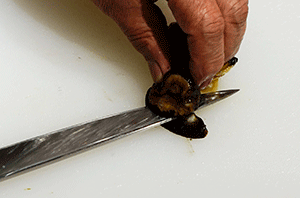 |
 |
| 1,Insert the cutting edge of the Yanagi blade knife between the shell lid and the muscle. | 7,false fusus shells and muscles have been cleaned and look better. |
 |
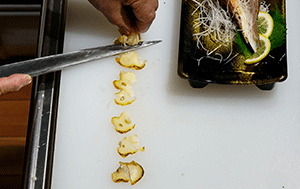 |
| 2,Cut off so as not to leave muscle on the shell lid. | 8,Slice thinly in the same way as turban shell. |
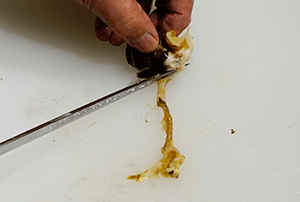 |
 |
| 3,Removes internal organs including the heart and salivary glands and hakama from muscles. | 9,The amount of one thinly sliced false fusus. |
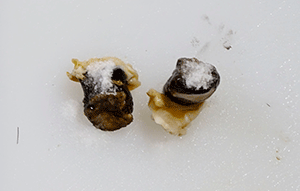 |
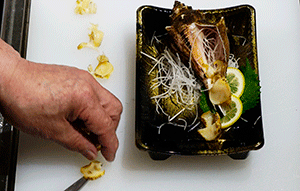 |
| 4,Sprinkle salt on two muscles of false fusus. | 10.Scoop the sliced false fusus with the tip of a Yanagi knife and serve it in a container. |
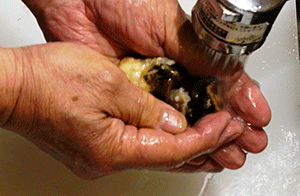 |
 |
| 5,After rubbing the muscles with salt by hand, rinse the salt with running water. | 11,false fusus sashimi assortment |
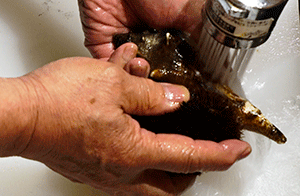 |
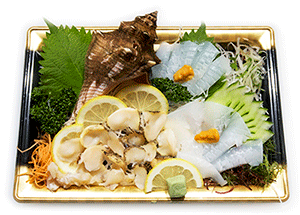 |
| 6,Use an instrument such as a kamenokou tawashi to wash off moss and dirt on the surface of the shell. | 12,False fusus assorted sashimi |
I would like to have a store that has a wide selection of live shellfish and live shellfish products.
What if the fish section had products like the false fusus assorted sashimi in the image above? The mere presence of these products is like an indication that "we are different from the other the fish section". Live shellfish, which are supposed to be eaten raw with sashimi, are valuable while they are alive, and when they die, their value is halved, so they are not easy to handle. Moreover, since the purchase price of these shellfish is generally not cheap, it is difficult to continue selling live shellfish while making a normal profit. So in Japan today, other ordinary the fish sections have no abalone, blood clam, tresus keenae, let alone false fusus, and even relatively cheap turban shells.
In other words, a store that has the fish section that normally displays live shellfish and live shellfish-related products will lead to differentiation from other companies by the assortment of the fish section. Live shellfish products have a high price due to the small proportion of edible parts, and are completely unsuitable for producing a sense of volume and cheapness, and are not suitable for business formats such as discount stores. Therefore, it is not necessary to sell live shellfish products at a bargain price, but to make them available to customers who feel their value.
In order to increase the value of live shellfish products as much as possible, the best way is to use shells. Not only this false fusus, but also live shellfish such as abalone, blood clam, tresus keenae, and turban shells are valuable only with shells. Therefore, if you are a company that claims to be aiming for a high-quality upgrade store rather than a bargain shop, I would like you to have a variety of such live shellfish products.
The food service industry has been severely damaged by the corona-stricken environment that has continued since last year, and retailers such as supermarkets seem to be doing well with a tailwind. At such times, we should act to have the fish section consume and purchase fish that had been robbed by taverns, etc., and in that sense, it can be said that a great opportunity has come.
At this time, the market price of high-class fish that had lost their destination due to the interruption of orders from the restaurants that had been purchased is falling, and high-class live shellfish are no exception, and it should be considered that the sales opportunity has come. I would like to see as many stores as possible offering products such as false fusus assorted sashimi.
| Please access the following URL if you want to secure using SSL. All pages in the site will be secure pages. |
https://secure02.blue.shared-server.net/www.fish-food.co.jp/message english 3.2021.html |
An opinion and the communication are to iinfo@fish food times
Date of updating 1 Mar. 2021
